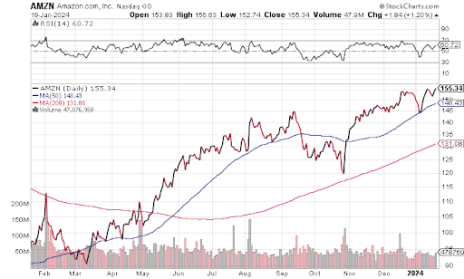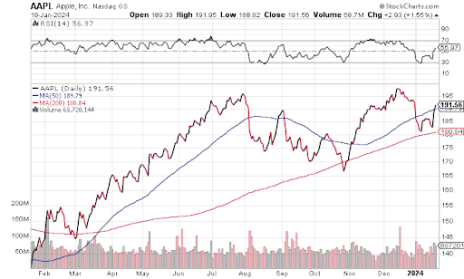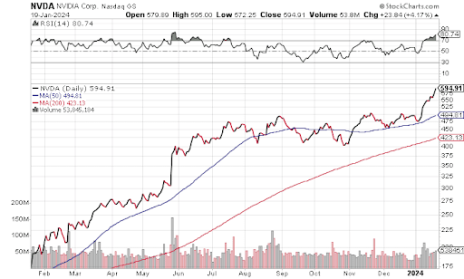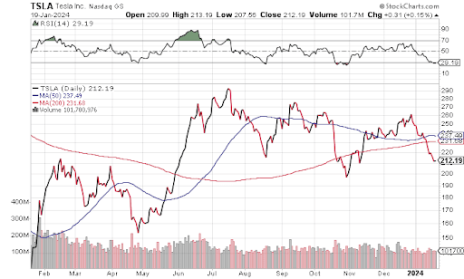According to Goldman Sachs’ 2024 U.S. Equity Outlook, the Magnificent Seven (Alphabet (GOOGL), Amazon (AMZN), Apple (AAPL), Meta (META), Microsoft (MSFT), Nvidia (NVDA) and Tesla (TSLA)) claimed the largest market cap share ever (29%) for just seven companies, and the S&P 500 would have returned a paltry 6% in 2023 without them.
That said, if you were invested in any of the seven in 2023, you saw some impressive returns. But the question now becomes, what does 2024 have in store for the Magnificent Seven?
After a slow start to the year, nearly all seven have quickly made up for lost time, as you’ll see in the charts below.
But, with the standard caveats about technical analysis not being predictive (my crystal ball is in the shop, etc., etc.), the technical picture looks very different for some of the Magnificent Seven stocks than others.
So, let’s take a look at the charts and see which look the technically strongest ahead of the rest of 2024.
Alphabet (GOOGL)
Alphabet (GOOGL) took a little longer than the other six to get started in 2023, but its bull run also lasted later in the year (into the fall). GOOGL consolidated some of the gains in the end of October and has since reentered a technical uptrend, setting higher highs and higher lows since the beginning of December.
Shares are currently trading just below all-time highs set in November of 2021, which would be the near-term target should the uptrend continue.
Amazon (AMZN)
Amazon (AMZN) had a strong rally for most of the year before retracing a little less than half its gains (healthy) in the fall months. Like GOOGL, AMZN remains in a technical uptrend, setting higher highs and higher lows since the end of October.
Shares are trading above both the 50- and 200-day moving averages, which are both upward trending. The rising 50-day line has just eclipsed September highs near 145 ( which also coincides with December lows) which points to technically strong support at those levels, should the uptrend falter.
Of the Magnificent Seven stocks, AMZN is second on my list of strongest technicals.
Apple (AAPL)
As you can see in Apple’s (AAPL) chart above, the first half of the year was a strong, consistent uptrend. Persistent overbought RSI readings (above 70) are a classical marker of a trending stock. The late-summer swoon in growth stocks was a period of consolidation for AAPL, with shares giving back about half of the prior run-up (healthy consolidation range) and then toying with their 200-day moving average in November.
Shares rebounded strongly in the last quarter of the year, setting new 52-week highs before what was likely end-of-year profit-taking or rebalancing brought shares back to their 50-day line. With the 50-day serving as only loose overhead resistance in the late summer and early fall, it offered no support in the early-January breakdown, but no resistance when shares broke through it to the upside later that month. The 200-day line, tested twice in 2023, would be the first place I’d look for technical support.
Shares are not currently trending, but support at these levels combined with higher highs early in 2024 would mark a resumption.
Meta Platforms (META)
Meta Platforms (META) is actually the best-looking Magnificent Seven stock from a technical standpoint. It’s got the RSI overbought markers that AAPL enjoyed during the first half of the year, hardly gave back any of its initial run during its consolidation period (instead, it consolidated sideways from August through the end of October) and is also in the midst of a technical uptrend (since the end of October).
A peek at a longer-term chart (not pictured) indicates that there’s nothing but white space ahead now that shares have broken all-time highs (September 2021).
Microsoft (MSFT)
Microsoft (MSFT) has a lot of the signs of technical strength that META enjoyed (a strong run in the first half of the year before consolidating sideways via time, not down via price) but showed more weakness to end the year.
Shares are currently in a period of “price discovery,” having broken through prior all-time highs (set in November), and are likely to be volatile given the rapid gains to start 2024.
Nvidia (NVDA)
Nvidia (NVDA) was the best-performing Magnificent Seven stock in the last year, having returned over 230%. That said, it spent half the year gradually grinding higher, failing to break out of its consolidation and really enter a technical trend until the calendar flipped.
Right now, the consolidation looks like it turned NVDA into a coiled spring, and shares have risen more than 20% already in 2024. At the end of the year, it looked like NVDA needed a strong breakout to get going, and it seems to have found it. I wouldn’t be surprised if it was quicker than the others to start moving sideways given the pace of its gains.
Tesla (TSLA)
From a technical standpoint, Tesla (TSLA) is the worst-looking Magnificent Seven stock. Shares have been trending lower since December and are currently trading below both their 50- and 200-day moving averages.
The 50-day line is also downward trending and is awfully close to the flat 200-day.
Even should shares reverse course here, TSLA will have multiple levels of overhead resistance to chew through before it can break above winter’s lows, let alone start sniffing new high ground.
I remain of the opinion that investors in the Magnificent Seven stocks who are coming off a year of really impressive overperformance should consider tactically allocating some proceeds to smaller-cap stocks (which have been ignored for years), but setting aside fundamentals, META, AMZN and MSFT would be my picks – META and AMZN for their current trends, and MSFT for its upside potential.









